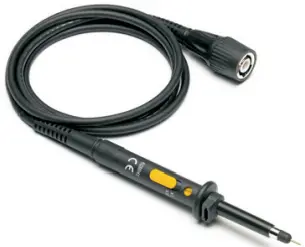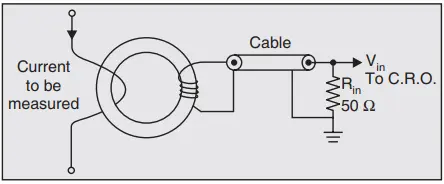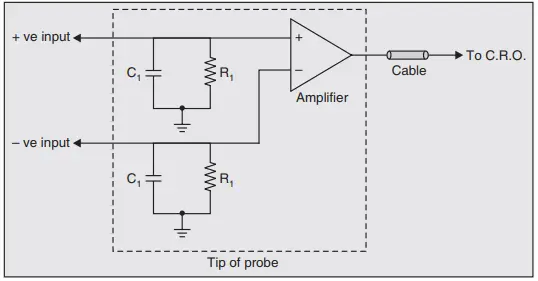Oscilloscope Probes
A probe is a conductor used to establish a connection between the circuit under test and the measuring instrument. While connecting the test circuit, the probe does not alter, load or disturbs the circuit and signal conditions to be analyzed.
The probe should have high impedance. The probe bandwidth should be as high as possible. It should be about 10 times the bandwidth of the oscilloscope. The ideal probe offers the following key attributes:
- Ease of connection
- Absolute signal fidelity
- Zero signal source loading
- Complete noise immunity
General diagram of probe is shown in Fig. 1. The probe tip is the signal sensing circuit. It may be passive or active. It consists of the resistors and capacitors if passive and in active it consists of active components like FET source follower circuit.

Fig. 2 shows a 60 MHz bandwidth oscilloscope probe x1/x10. A two position slide switch allows attenuation of either ×1 or ×10 to be selected.

The probe cable is a special coaxial type (with a resistive center conductor to damp out ringing), with quite-effective shielding. Its capacitance is greater than that of an open wire, and in some cases, such a probe is satisfactory. The probes are of many types, they are given below:
- Direct probe
- Isolation Probe
- High impedance or 10: 1 Probe
- Active Probes
- Current Probe
- Differential Probes
Now we will discuss the each type of probes in detail.
Direct Probe 1:1
The simplest types of probe are the test lead. Test leads are simply convenient lengths of wire for connecting the CRO input to the point of observation. At the end of CRO, they usually terminate with lugs, banana tips or other tips to fit input jacks of the scope, and at the other end has a crocodile clip or any other convenient means for connection to the electronic circuit.
The CRO has high input impedance and high sensitivity. So the test leads should be shielded to avoid hum pickup, unless the scope is connected to low impedance high level circuits.
While using the shielded probe, the shunt capacitance of the probe and cable is added to the input impedance and capacitance of the oscilloscope and acts to lower response of the oscilloscope to high impedance and high frequency circuits.
Isolation Probe
The input capacitance of the scope and the stray capacitance of the test lead are very high. It causes the sensitive circuit to break into oscillation when CRO is connected. This effect can be prevented by an isolation probe. The isolation probe is made by placing a carbon resistor in series with test lead.
An isolation probe is employed to avoid the undesirable circuit loading effect of the shielded probe. This probe causes a slight change in the amplitude of the waveform and a slight change in the wave shape. To avoid this possibility, a high impedance compensated probe, called a low capacitance probe or a 10:1 probe is used.
High Impedance or 10: 1 Probe
This probe is also known as passive voltage probe. The basic function of this probe is to increase the input impedance and reduce the effective input capacitance of an oscilloscope. This probe head uses a resistor and a capacitor combination.
The resistance R1 is shunted by an adjustable capacitor C1. This capacitor is called compensating capacitor. A co-axial cable connects the probe head to the CRO input as shown in Fig. 3.

Let C2 be the probe cable equivalent capacitance. The input resistance and capacitance of CRO can be referred to as Rin and Cin. The typical values of Rin and C in are 1 MΩ and 20 pF.
Active Probe
The active probes are used for connecting fast rising and high frequency signals. These probes are very useful for small signal measurements as their attenuation factor is very small. The block diagram of the active probe is shown in Fig. 4.

As seen from this figure, the active probe consists of an active element like FET source follower circuit and BJT emitter follower circuit along with a co-axial cable termination.
FET is used as an active element to amplify the signal. The voltage gain of FET source follower is unity but it provides a power gain due to which input impedance increases. The output impedance of FET source follower is very low and hence eliminates the loading effect.
Instead of connecting cable directly to CRO from FET stage, one more stage of BJT emitter follower is introduced. This emitter follower drives the cable and helps further in solving the problems of improper impedance matching.
These probes are more expensive and bulky than passive probes, but they are useful for small signal measurements, because their attenuation is less.
Active probes have limited use because the FET probe effectively becomes an attenuator probe. So the oscilloscopes are typically used with 10:1 attenuator probe.
Current Probe
This probe provides a method of inductively coupling the signal to the CRO input. The direct electrical connection between the test circuit and CRO is not necessary. This probe can be clamped around a wire carrying an electrical current without any physical contact to the probe. Thus the magnitude of current with a frequency range from d.c to 50 MHz can be measured using this probe.
The current sensor consists of two parts: A conventional transformer for transforming alternating current to voltage, and a Hall effect device for converting direct current to a voltage. The current probe is shown in Fig. 5.

A magnetic core with a removable piece is used as the coupling element for the current probe. The wire carrying the current to be measured is inserted in the center of the magnetic core and acts as a primary of a transformer.
The core is the ferrite U shaped and work as secondary of the transformer. Because of the electromagnetic induction principle, whenever current flows through primary, the e.m.f gets induced in the secondary. This is fed to the CRO input via termination circuitry.
When a d.c current flows through the wire, it will not appear at the secondary. In addition to this flux in core may increase causing the saturation of the core which is undesirable. This provides inaccurate measurements. To avoid this problem Hall Effect sensor and a feedback amplifier is added to the probe.
Differential Probes
This is a type of active probe shown in Fig. 6. It has two inputs, positive and negative. It has a separate ground lead and it drives single terminated 50 Ω cable to transmit its output to one oscilloscope channel.

This output voltage signal is proportional to the difference between the voltages appearing to the input terminals. There is a restriction that the two input signals must be within a few volts from ground so that signals can stay within the dynamic range of the probe.
The output is proportional to the difference between the two inputs and hence the name, differential probe. It rejects the common mode signal but still some error voltage results proportional to common mode signals like noise.
The common mode rejection power can be measured by connecting both the input simultaneously to the same input. The rejection is best for d.c and at low frequencies. But at high frequencies the rejection is poor.
Such probes can handle the signals which are typically less than a few volts only. The peaks above certain amplitude will be clipped in such probes. This probe is bulky, expensive, having less dynamic range and requires external power supply.